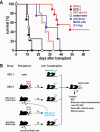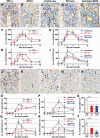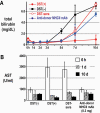Suppression of liver transplant rejection by anti-donor MHC antibodies via depletion of donor immunogenic dendritic cells
- PMID: 33258927
- PMCID: PMC8060989
- DOI: 10.1093/intimm/dxaa076
Suppression of liver transplant rejection by anti-donor MHC antibodies via depletion of donor immunogenic dendritic cells
Abstract
Background: We previously found two distinct passenger dendritic cell (DC) subsets in the rat liver that played a central role in the liver transplant rejection. In addition, a tolerance-inducing protocol, donor-specific transfusion (DST), triggered systemic polytopical production of depleting alloantibodies to donor class I MHC (MHCI) antigen (DST-antibodies).
Methods: We examined the role of DST-antibodies in the trafficking of graft DC subsets and the alloresponses in a rat model. We also examined an anti-donor class II MHC (MHCII) antibody that recognizes donor DCs more selectively.
Results: Preoperative transfer of DST-antibodies or DST pretreatment eliminated all passenger leukocytes, including both DC subsets and depleted the sessile DCs in the graft to ~20% of control. The CD172a+CD11b/c+ immunogenic subset was almost abolished. The intrahost direct or semi-direct allorecognition pathway was successfully blocked, leading to a significant suppression of the CD8+ T-cell response in the recipient lymphoid organs and the graft with delayed graft rejection. Anti-donor MHCII antibody had similar effects without temporary graft damage. Although DST pretreatment had a priming effect on the proliferative response of recipient regulatory T cells, DST-primed sera and the anti-donor MHCII antibody did not.
Conclusion: DST-antibodies and anti-donor MHCII antibodies could suppress the CD8+ T-cell-mediated liver transplant rejection by depleting donor immunogenic DCs, blocking the direct or semi-direct pathways of allorecognition. Donor MHCII-specific antibodies may be applicable as a selective suppressant of anti-donor immunity for clinical liver transplantation without the cellular damage of donor MHCII- graft cells and recipient cells.
Keywords: CD8 T cells; donor-specific transfusion; leukocyte trafficking; multicolor immunohistochemistry; sensitization pathway.
© The Author(s) 2020. Published by Oxford University Press on behalf of The Japanese Society for Immunology.
Figures






References
-
- Saiki, T., Ezaki, T., Ogawa, M. and Matsuno, K. 2001. Trafficking of host- and donor-derived dendritic cells in rat cardiac transplantation: allosensitization in the spleen and hepatic nodes. Transplantation 71:1806. - PubMed
-
- Wood, K. J. 2003. Passenger leukocytes and microchimerism: what role in tolerance induction? Transplantation 75(suppl. 9):17S. - PubMed
-
- Lechler, R., Ng, W. F. and Steinman, R. M. 2001. Dendritic cells in transplantation—friend or foe? Immunity 14:357. - PubMed
Publication types
MeSH terms
Substances
LinkOut - more resources
Full Text Sources
Research Materials

